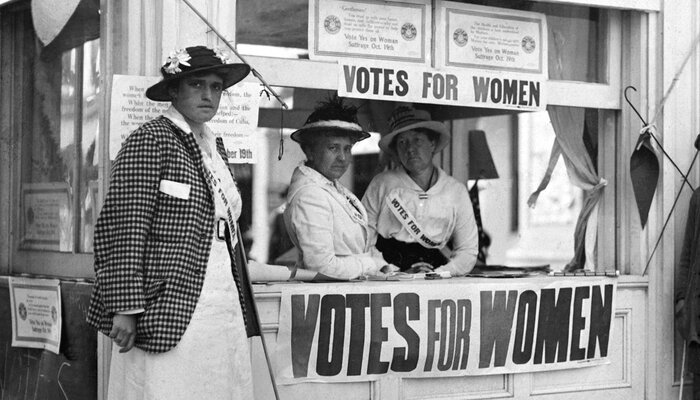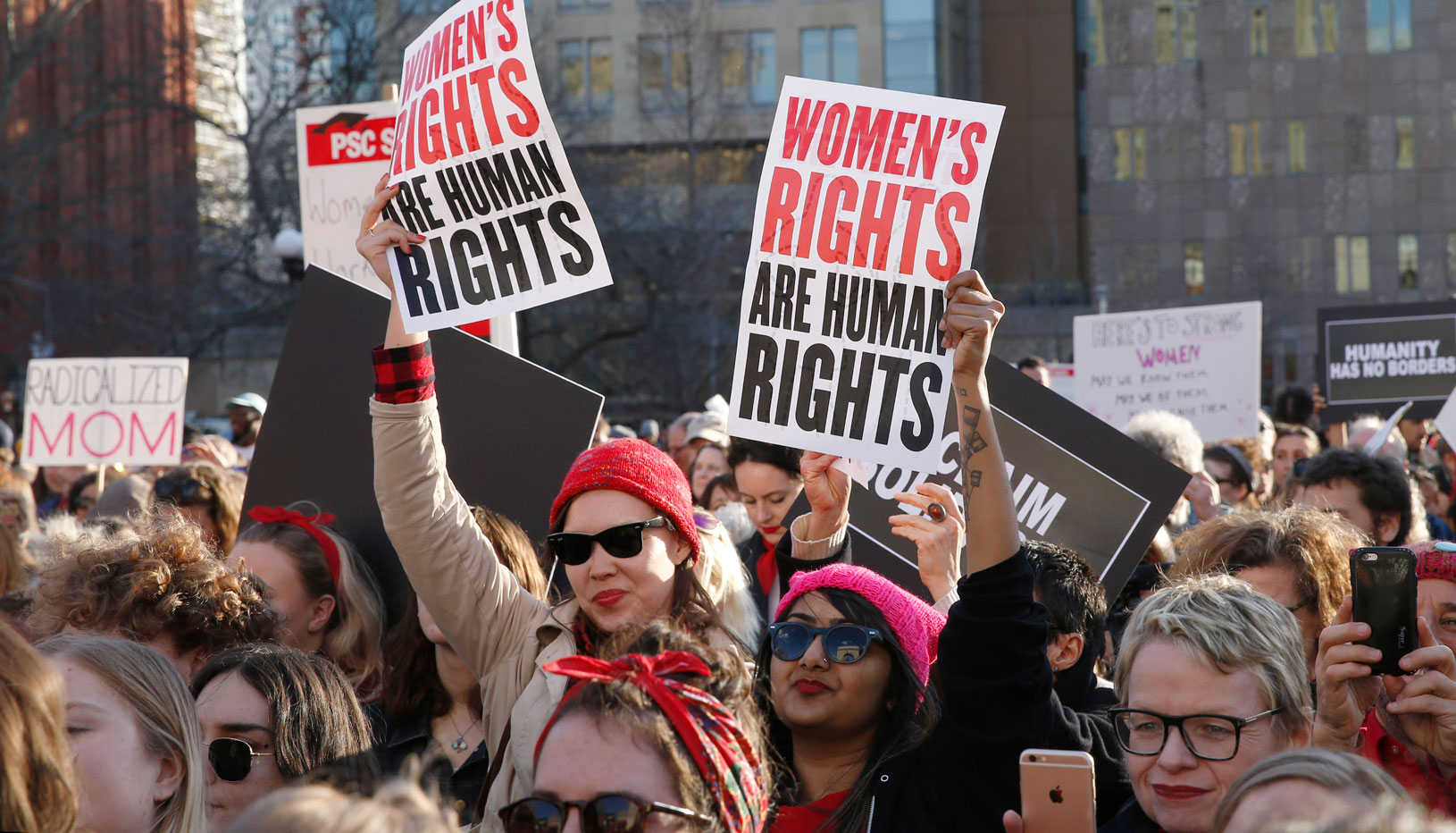Today we celebrate the 100th anniversary of the ratification of the 19th Amendment, which guaranteed that the right to vote could not be denied “on account of sex.” The story of the amendment’s success, as well as the enduring legacy of the suffrage movement’s missteps, has renewed relevance today.
The struggle for ratification
From the year-long battle to ratify the 19th Amendment, two anecdotes stand out. It’s almost been forgotten that the final push to win the right to vote coincided with the Spanish flu pandemic, which killed 650,000 Americans between 1918 and 1920. While the deadliest waves had passed by the time Congress passed the amendment in 1919, outbreaks lingered across the nation. Among the ill was Oklahoma suffragist Aloysius Larch-Miller, a 33-year-old social worker, nurse, and activist. On January 31, 1920, her state was considering the suffrage question.
At that point, 32 of the necessary 36 states had ratified the amendment. Determined to see Oklahoma on the right side of history, Larch-Miller “disobeyed her doctor’s orders and attended a Democratic county convention,” according to the New York Tribune. There, she gave a “speech seldom equalled on any political convention floor,” successfully prodding the state party to hold a special session for the adoption of women’s suffrage. The triumph cost Larch-Miller her life two days later, as she died from the flu. But her sacrifice wasn’t in vain — Oklahoma ratified the amendment the next month.
By August 1920, the suffrage movement was one state away from victory. Tennessee was the final battleground. When the legislature split nearly evenly on the question, the vote came down to a single state representative — 24-year-old Harry T. Burn, the youngest member of the assembly. It’s a story that’s been told time and again: as Burn wrestled with his stance, he received a note from his mother imploring him to “be a good boy” and “vote for suffrage.” Burn listened to his mother, casting the decisive vote that, 100 years ago today, added the 19th Amendment to the Constitution.
The experiences of Larch-Miller and Burn resonate today. Like Larch-Miller, millions of Americans are risking their own safety during a pandemic, taking to the streets to protest for Black lives and against police brutality. Like Burn, Illinois Republican State Rep. Steve Andersson defied the party line and led his state legislature’s ratification of the Equal Rights Amendment in 2018. The causes may be contemporary, but the spirit is the same.
Achieving equality for women of color
The 19th Amendment was revolutionary, and it dramatically altered the shape of our electorate. But its legacy, and its history, have been mythologized and obfuscated. For one, the 19th Amendment, like so many parts of our Constitution, initially failed to live up to its promise.
The suffrage campaign was one characterized by radical change and radical exclusion, by democratic expansion and racist omission. Despite the amendment’s ratification in 1920, it took decades of further work and additional legislation for the nation’s women of color, especially Black, Native American, and Asian-American women, to gain access to the ballot.
Also, while the popular timeline dates the origins of the suffrage movement to the 1848 Seneca Falls Convention, this history is heavily fictionalized. The real movement stretches back at least a century earlier.
The earliest reported instance of an American woman casting a ballot was in 1756, when Lydia Chapin Taft voted in Massachusetts. Widowed and propertied, Taft was deemed eligible to vote in her husband’s stead in several town meetings. Nor was hers a lone case. New Jersey’s 1776 Constitution actually granted expansive voting rights with no regard for gender or color. Remarkably, this system lasted for three decades, finally ending as sexism and racism motivated restrictions to the franchise. And before formal suffrage organizations formed, women advocated for their rights in tandem with the other great causes of the early 19th century — the abolitionist and temperance movements.
Why do we only focus on the part of the story between 1848 and 1920? As Kate Clarke Lemay, historian and curator of the National Portrait Gallery’s Votes for Women project, said recently, it’s because activists Susan B. Anthony and Elizabeth Cady Stanton told us to. The two women wove the myth about their foundational roles, and in doing so covered up a less than rosy picture of the suffrage movement itself. In the 1880s, they crafted the popular narrative about the movement’s origins in 1848, and “because there was so little recorded history from that time it was taken as fact.”
To be sure, Stanton and Anthony had crucial roles in the movement. But in their quest for “equality,” both were willing to win the vote for white women at the expense of everyone else — partnering with white supremacists and Southern Democrats, opposing the 15th Amendment, and disparaging both men and women of color. And they were far from the only white suffragists to use these tactics.
The racist underpinnings of the suffrage movement, and the knowledge that it left so many women behind, can be difficult to square with the importance of the 19th Amendment to our democracy. But we can celebrate the amendment by lifting up those who continued to fight for an inclusive and expansive democracy, despite the politics of the era.
People like Ida B. Wells-Barnett, the anti-lynching journalist recently awarded with a posthumous Pulitzer Prize, who defied the segregated parade at the 1913 Women’s March on Washington and marched with her state’s delegation. Zitkála-Šá, a Yankton Dakota Sioux author and co-founder of the National Council of American Indians, who helped lobby for Native American voting rights after the passage of the 1924 Indian Citizenship Act. Mabel Ping-Hua Lee, an activist and immigrant from China, who championed the suffrage cause in New York as a teenager, even though the Chinese Exclusion Act barred her from obtaining citizenship (and would continue to do so until 1943). There were also many white women, including Lucy Stone and Julia Ward Howe, who insisted on an inclusive approach from their leadership positions within suffrage organizations. Women won the vote thanks to diverse and diligent activists and advocates, none of whom should be forgotten.
Beyond the right to vote
The 19th Amendment did not end the profound social and economic inequities that women face in the United States. But it did crack open the door for their political voices to be heard alongside men — a door that has only swung wider over the years. From education to jobs to political office, the country has been radically and beneficially reshaped over the last century, in no small part thanks to the inclusion of women in the electorate.
And even still, just as the 19th Amendment was tainted by racism, today’s opportunities and disparities don’t cut evenly across the spectrum. The gender pay gap is much larger for many women of color, especially Black, Latina, and Native American women, than it is for white women. Likewise, amidst the massive job loss during the coronavirus pandemic, women of color have been far more likely to lose their employment. Transgender women, especially trans women of color, face unique threats to their safety and identity.
The revived fight for the Equal Rights Amendment, first written nearly a century ago, is symbolic of how this perennial national conversation for gender justice continues to this day. While the ERA’s status remains in limbo, awaiting the outcome of dueling lawsuits, it’s possible that Virginia’s milestone ratification of it on January 15 could finally add a 28th Amendment to the Constitution.
Danica Roem, a Virginia state representative and the first openly transgender person elected to any state legislature, spoke before her state’s decisive vote. She emphasized the inclusionary nature of the ERA, declaring that “today, rather than single out someone, rather than leave someone behind, we are making a statement of affirmation about what we are for — not who we are against.”
To celebrate the centennial of the 19th Amendment — and the broader goal of gender equality — we should embrace Roem’s closing words: “It is your United States of America too.”
The views expressed are the author’s own and not necessarily those of the Brennan Center.


